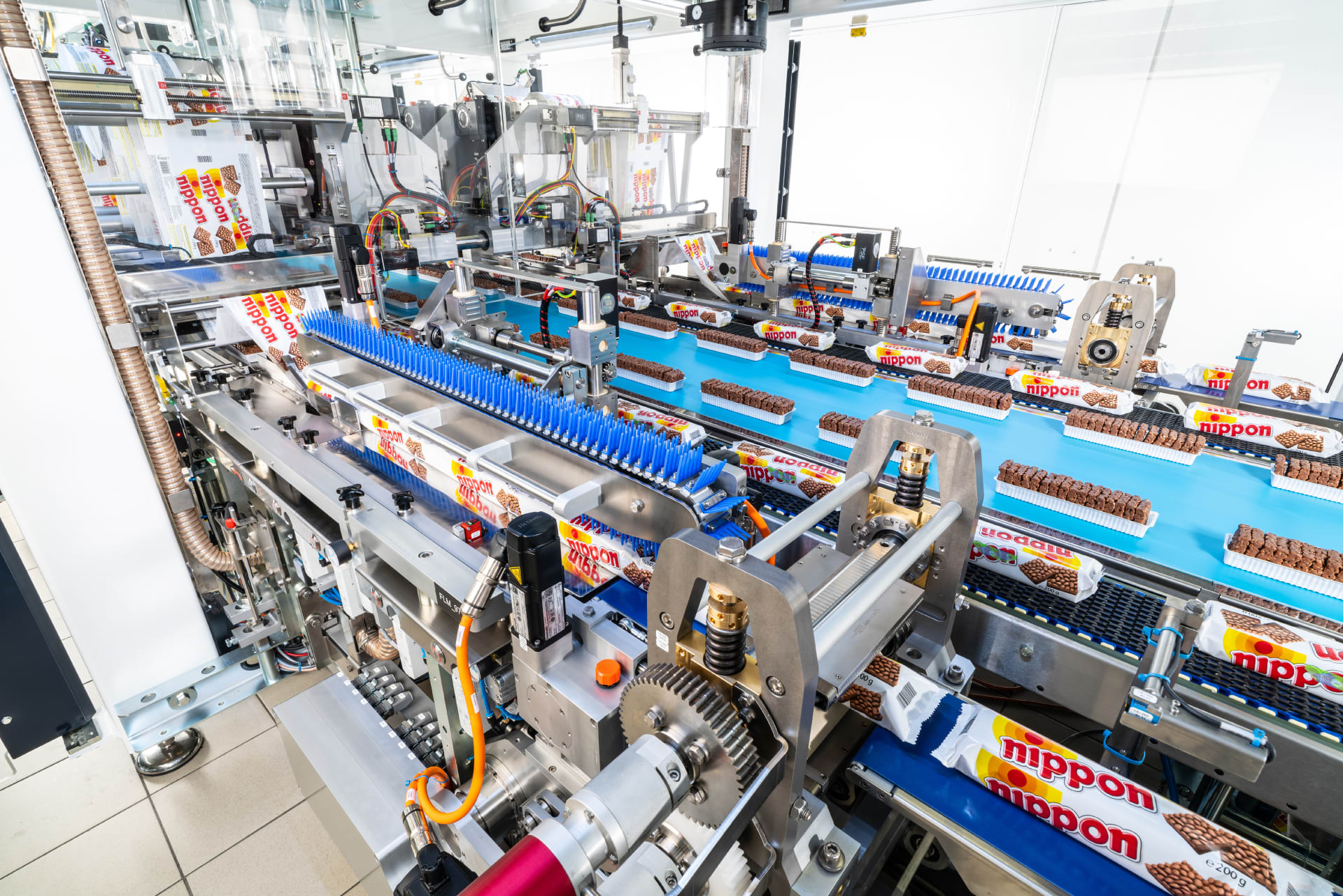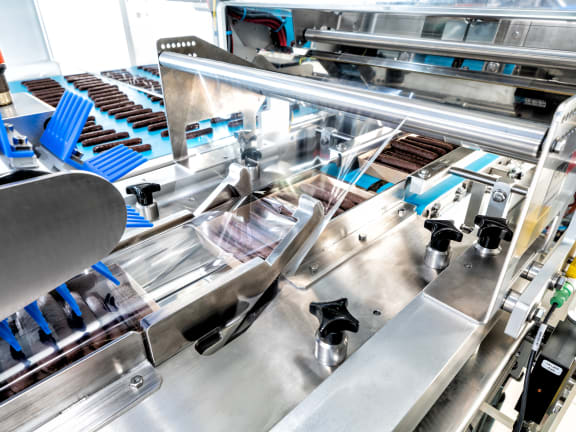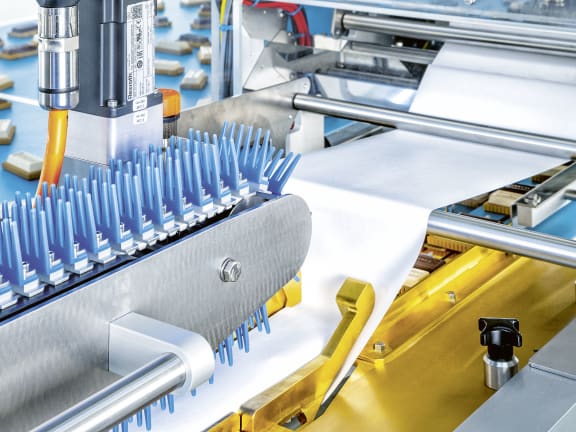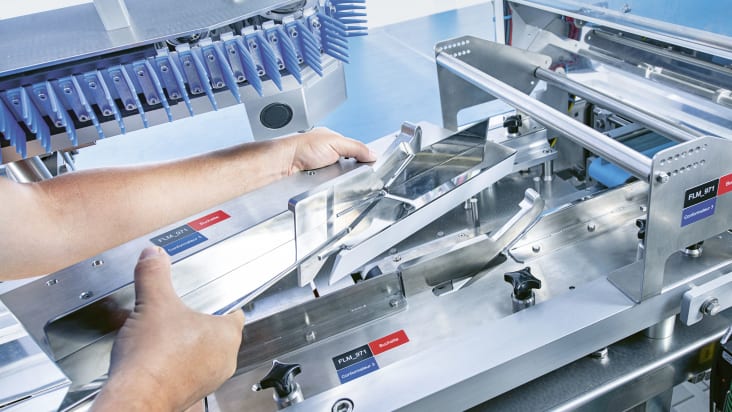Two main types of sealing have so far dominated the market for flow-wrap packaging – cold-sealing and conventional heat-sealing. The frequently used cold seal films are usually tailored to a very specific product and printed accordingly. The material is only coated with a latex-based adhesive at the intended bonding points. To close the sealing seam, the sealing unit presses the glued areas together with pressure. As the sealing is only achieved via the separately applied adhesive, the film material does not require a sealing layer. Sealing without the influence of heat makes cold-seal films ideal for packaging heat-sensitive products such as chocolate bars.
Cold-seal films are very easy to process. This is because, in contrast to conventional heat-sealing, time hardly plays a role when processing cold-sealing films. Therefore, packaging can be carried out at high film speeds of 60 metres per minute or more. Nevertheless, cold-seal films do have some disadvantages for manufacturers and consumers: They are somewhat more expensive than heat-seal films and have a limited shelf life due to the adhesive properties. Even when stored optimally without temperature fluctuations and UV radiation, the material ages and cannot be sealed properly. For consumers who are allergic to latex, the latex content in the adhesive can be a problem. Moreover, threads are formed when opening the splice of a cold-sealed flowpack. A flow-wrapping machine that can only perform cold-sealing cannot be converted to a heat-sealing system, or only at great expense, and therefore offers no flexibility in terms of the sealing system.

Thanks to the Flowpacker’s unique sealing system, Schubert offers its customers exceptionally high flexibility when packing products into flowpacks.
A flexible and gentle sealing system from Schubert
Heat-sealing has several advantages over cold-sealing. However, the trend towards more sustainable packaging materials is difficult to implement even with the existing heat-sealing technology. This is because newly developed solutions such as recyclable mono films or sustainable paper-based films are more complex when it comes to sealing. This calls for more flexible technologies in the flow-wrapping machine that can process both conventional heat-seal films and more sustainable variants. In general, the sealing seam in heat-sealing is not only created by pressure, but above all by heat input at the sealing point. Conventional heat-sealing films are composite materials that are provided with a continuous sealing layer on the sealing side. The heat causes the sealing layers of the two film parts to melt slightly at the intended sealing seam and form a bond.
With conventional heat-sealing, the heat is supplied by heated sealing jaws or rollers, similar to an electric hotplate, and penetrates the flowpack film from the outside at up to 200 degrees Celsius right through to the sealing layer. This is different with ultrasound: The friction created between the sealing surfaces by the oscillating sonotrodes generates the melting temperature exactly where it is needed. This allows the sealing layers to bond together. The sealing tools remain virtually cold. With ultrasound, the heat is therefore generated precisely at the point of adhesion and, unlike conventional heat-sealing, does not have to penetrate the film from the outside to the inside. This makes ultrasonic sealing an exceptionally gentle process that is often used for sensitive products in the pharmaceutical industry or for heat-sensitive foods such as chocolate. Ultrasonic sealing is advantageous even for thicker films with high impermeability, but especially for the latest sustainable film types. This is because in the case of mono films, the entire film has more or less the same melting temperature. This can damage the film on the outside before the temperature on the inside has reached the bonding point. In contrast, the outer layer of composite films usually has a much higher melting point. Paper-based films can also be sealed better with ultrasound than with conventional hot technologies, as the heat insulation of the paper is of no importance and the outer layers have to be less heat-resistant.
So how can these technologies best be used to become more flexible in sealing? The answer is called the Flowpacker. With its flow-wrapping machine, Schubert offers a highly flexible solution that can process both conventional and sustainable films. For this purpose, Schubert uses not only ultrasonic technology, but alternatively ceramic heating elements for longitudinal sealing. These heating elements do not consist of a complete sealing jaw, but rather of numerous individual ceramic elements or segments measuring 5 x 5 millimetres. These heat up extremely dynamically and cool down many times faster than conventional heating plates. As well, each element can be controlled individually. This makes the heat applied during the sealing process very easy to control, to dose and as gentle as ultrasound.
The special sealing system in the Flowpacker combines gentle and flexible sealing with the ceramic heating elements or ultrasonic sealing for longitudinal sealing with a unique, robot-assisted heat-sealing technology for cross-sealing. The flying cross-sealing unit is a small robot with three NC axes and enables the sealing process to be precisely programmed in terms of temperature and duration, and kept constant throughout the process. This ensures that the sealing time remains identical, even if the chain speed changes. For example, lower temperatures can be used with a longer sealing time. The sealing process is so gentle that even sensitive products and sustainable flowpack films can be processed in the Flowpacker without any problems. This way, manufacturers remain flexible in the marketplace for years to come and are ideally positioned for the trend towards sustainable packaging solutions.






